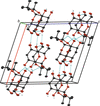issue contents
August 2021 issue

Cover illustration: Co-operative nonconventional sp2-C—H⋯N hydrogen bonds control the conformation of a dipyridyl molecule to a rhombus shape. See Bosch, Bowling & Oburn [Acta Cryst. (2021), C77, 485–489].
scientific commentaries
Open  access
access
 access
accessAlthough L-DOPA is a major drug that has been used for more than 50 years to treat the motor symptoms of Parkinson's disease, the Cambridge Structural Database contains only two structures in which it is coordinated to a metal. Why are there not more? The new structure is also notable for an approximate 42 axis.
letters to the editor
Download citation


Download citation


Because an IUCr/IUPAC-designated set of letters/numbers identifies the configuration of the atoms linked to the PbII atom in its coordination compounds, a Ψ prefix before such as a polyhedral symbol provides useful information when its lone pair is stereochemically active. The polyhedral symbols for the crystal structures in some 50 articles published after 2000 are reported here as the original studies did not expressly identify coordination geometries.
research papers
Download citation


Download citation


The structure of [Zn(L)3](NO3)2·3CH3CN, with a Λ-helical [ZnL3]2+ mononuclear complex cation, has been determined by single-crystal X-ray diffraction (L is an O,N-bidentate ligand). The Λ-helicity is induced by pendant L-alanine residues, through intramolecular interactions, namely, hydrogen bonding and aromatic stacking, between two coordinated chiral ligands.
CCDC reference: 2091352
Download citation


Download citation


2-Mercapto- and 4-mercaptopyridine in iodine solution condense into dithiopyridines. In the crystalline state, these compounds exist as protonated molecules embedded in a network of iodine molecules and iodide anions. All the molecular components are stabilized by various intermolecular interactions, viz. hydrogen, halogen and chalcogen bonds.
Download citation


Download citation


Crystal structure analyses showed the conformational properties of 3-methyl-5-spirofluorenehydantoin derivatives associated with different linker lengths and different substituents on the piperazine ring. Docking calculations indicated the same region of the glycoprotein P internal cavity as the most probable binding site for all the docked compounds, wherein the docking scores of the five-carbon alkyl chain derivatives were in a higher range in comparison to those of the three-carbon alkyl chain analogues.
Download citation


Download citation


A rare case of a 2:2:1 ternary cocrystal consisting of trithiocyanuric acid and two pyridine sulfides is reported, of which 1,4-bis(pyridin-4-yl)tetrasulfane is characterized by X-ray diffraction for the first time.
CCDC reference: 2074264
Download citation


Download citation


Co-operative nonconventional sp2-C—H⋯N hydrogen bonds control the conformation of a dipyridyl molecule to a rhombus shape.
CCDC reference: 2097561
Download citation


Download citation


The X-ray crystal structure of isopropyl 3-deoxy-α-D-ribo-hexopyranoside (isopropyl 3-deoxy-α-D-glucopyranoside) was determined and compared to the structures obtained previously for three related compounds. Density functional theory (DFT) calculations were used to validate the trends observed in bond lengths, angles and torsion angles in these structures.
CCDC reference: 2098123


 journal menu
journal menu

























